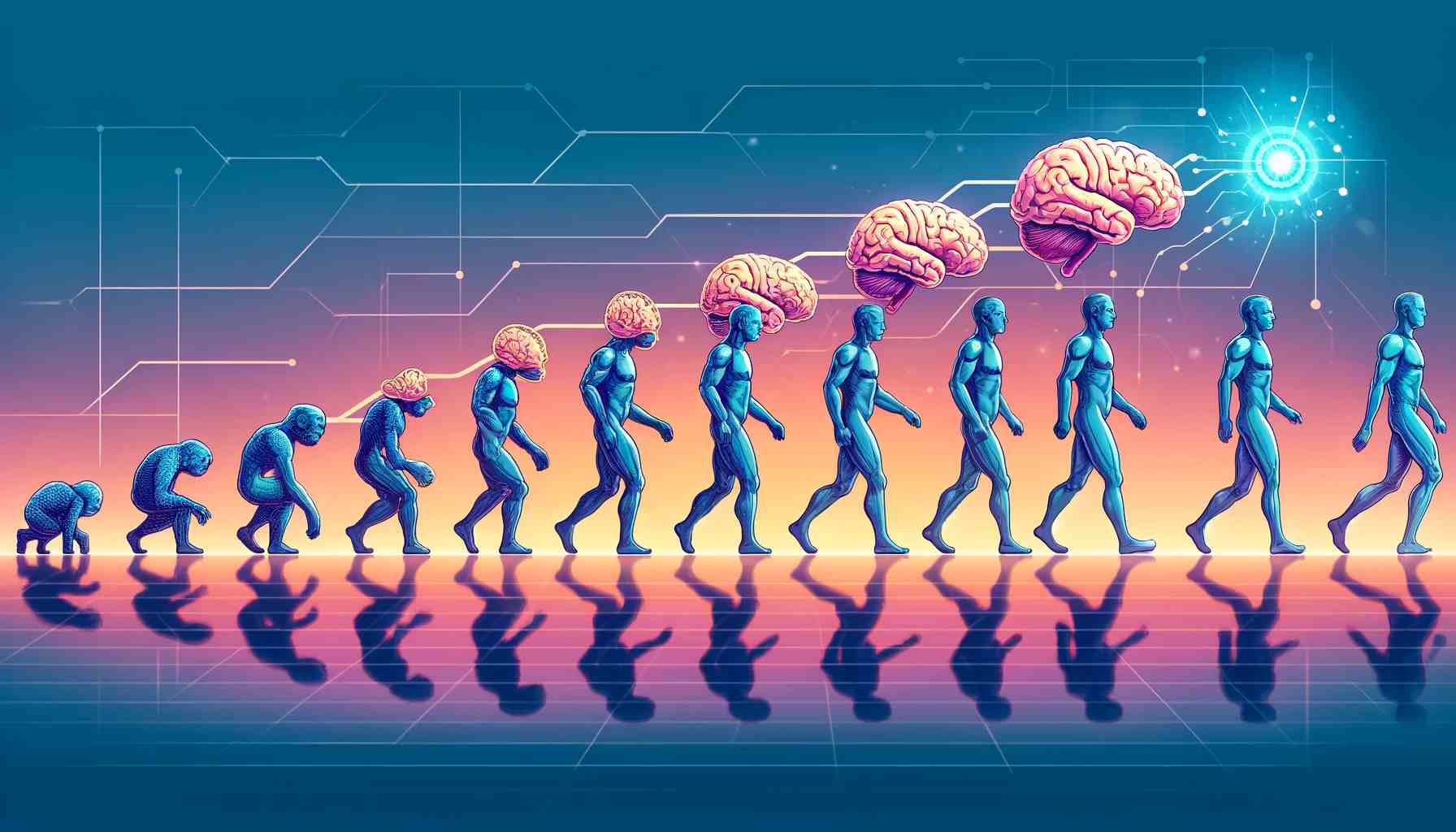Artificial Intelligence (AI) continues to revolutionize various sectors, with significant advancements in language models such as OpenAI’s Generative Pre-trained Transformers (GPT). This article delves into the evolution from GPT-1 to the latest GPT-4o, highlighting the improvements and innovations that each version brought to the table, particularly in content creation.

1. Evolution of Chat GPT Over Time
The ChatGPT development history from OpenAI’s language models, particularly the GPT series, is a fascinating journey of technological advancements. Let’s explore the Chat GPT evolution from the earliest versions to the latest, GPT-4o, and understand how each iteration has contributed to the field of AI.
2. What Was GPT-1 and How Did It Start?
GPT-1: The journey began with the first Generative Pre-trained Transformer (GPT) model, introduced by OpenAI in 2018. GPT-1 was a breakthrough in natural language processing (NLP), utilizing 117 million parameters to generate human-like text based on the context provided. It marked a significant step forward in machine learning, demonstrating the potential of pre-trained transformers.
Key Features of GPT-1:
- Contextual Understanding: GPT-1 could generate coherent text by understanding the context of the input.
- Pre-training and Fine-tuning: The model was pre-trained on a diverse dataset and then fine-tuned for specific tasks, enhancing its versatility.
Limitations of GPT-1:
- Limited Capacity: With only 117 million parameters, GPT-1 had a limited capacity for understanding and generating complex text.
- Performance Issues: While revolutionary, GPT-1’s performance was not robust enough for many practical applications.
3. How Did GPT-2 Improve on Its Predecessor?
GPT-2: Launched in 2019, GPT-2 built upon the foundation laid by GPT-1, expanding the model to 1.5 billion parameters. This massive increase in scale enabled GPT-2 to generate more coherent and contextually relevant text, making it a more powerful tool for a variety of NLP tasks. The revolution of GPT has begun.
Key Features of GPT-2:
- Improved Text Generation: The larger model size allowed for more accurate and diverse text generation.
- Versatility: GPT-2 could handle a wide range of applications, from summarization to translation and question-answering.
Limitations of GPT-2:
- Ethical Concerns: Due to its ability to generate highly realistic text, there were concerns about the potential misuse of GPT-2 for creating fake news or misleading content.
- Resource Intensive: The model required significant computational resources for both training and deployment.
4. What Made GPT-3 a Game Changer?
GPT-3: Released in June 2020, GPT-3 was a monumental leap forward, boasting 175 billion parameters. This vast increase in model size brought unprecedented capabilities in natural language understanding and generation.
Key Features of GPT-3:
- Versatile Applications: GPT-3 could perform a wide array of tasks, from simple text completion to complex creative writing.
- Natural Language Understanding: The model demonstrated a deep understanding of context, producing highly coherent and contextually appropriate text.
- Accessibility: OpenAI provided an API, making GPT-3 accessible to developers and businesses for integration into various applications.
Limitations of GPT-3:
- Resource Demands: The enormous size of GPT-3 made it resource-intensive, requiring substantial computational power.
- Occasional Inconsistencies: Despite its capabilities, GPT-3 sometimes generated contextually incorrect or irrelevant responses.
- Current Internet Access: GPT-3 does not have direct access to the internet for retrieving real-time information or updates.
5. How Did GPT-4 Address the Challenges of GPT-3?
GPT-4: Introduced in 2023, GPT-4 aimed to refine and enhance the capabilities of GPT-3. It focused on improving accuracy, efficiency, and contextual understanding.
Key Innovations in GPT-4:
- Enhanced Accuracy: GPT-4 reduced the occurrence of irrelevant or nonsensical outputs, making it more reliable.
- Adaptive Learning: Improved fine-tuning mechanisms allowed the model to better adapt to specific tasks and industries.
- Efficiency: Optimized algorithms reduced resource consumption, making the model more accessible and cost-effective.
- Current Internet Access: GPT-4, like its predecessor, does not have real-time internet access but benefits from a larger, more diverse training dataset.
5.1 What Makes GPT-4o Stand Out?
GPT-4o: Released in May 2024, GPT-4o represents the latest advancement in OpenAI’s language models, building upon the strengths of its predecessors while introducing several groundbreaking features.
Key Enhancements in GPT-4o:
- Conciseness and Discipline: GPT-4o delivers more concise and disciplined responses, making it ideal for professional and academic applications.
- Structured Explanations: It provides better-structured explanations, particularly in scientific and technical contexts, enhancing clarity and understanding.
- Creative Writing: The model excels in creative writing tasks, generating more coherent and imaginative content.
- Programming Assistance: GPT-4o can generate comprehensive code snippets, making it a valuable tool for developers.
- Literary Analysis: It offers more detailed and insightful literary analysis, benefiting students and researchers.
Current Internet Access: GPT-4o continues the trend of being a pre-trained model without real-time internet access but uses the most updated and extensive training data available.

6. Why Is the Evolution of GPT Important?
The evolution from Chat GPT-1 to GPT-4o underscores the rapid advancements in AI technology. Each iteration has brought significant improvements, enhancing the capabilities and applications of language models. GPT-4o, with its refined features and versatile applications, marks a new era in AI, setting the stage for even more innovative developments in the future.
By understanding these advancements, we can better appreciate the potential of AI in transforming various industries and driving technological progress.
7. What Are the Future Plans for GPT Models?
Future plans for the development of GPT models encompass several key areas aimed at further enhancing their functionality, performance, and ethical considerations. Here are some of the primary directions in which future GPT versions may evolve:
7.1 Increased Scale and Precision
Future models are likely to be even larger and more complex, enabling better contextual understanding and more precise responses. Increasing the number of parameters and refining algorithms could lead to more advanced AI capabilities.
7.2 Better Resource Management
One of the main goals is to reduce the resources required for training and deploying models. Optimizing algorithms and utilizing more efficient machine learning techniques will allow for lower energy consumption and faster training processes.
7.3 Improved Ethics and Safety
The development of GPT models will focus on enhancing their ethical and safety measures. This includes creating mechanisms to prevent the generation of harmful or inappropriate content and developing transparency in AI operations.
7.4 Integration with Real-World Data
Future models may be better integrated with real-time data and systems, enabling more dynamic and contextual responses. The ability to integrate with live databases and updated information can significantly increase the practicality of GPT models in real-world applications.
7.5 Development of Specialized Modules
Efforts will continue towards developing specialized modules tailored to specific industries or tasks. This will enable better customization of AI models to meet the needs of various sectors such as healthcare, law, education, and marketing.
7.6 Multimodal Interactions
Future versions of GPT may advance towards better handling of multimodal data, integrating text, images, audio, and other forms of data. This will allow AI to understand and generate content in a more comprehensive manner.
7.7 Personalization
Future models might offer greater personalization capabilities, allowing users to tailor the AI’s behavior to their specific needs and preferences. Personalized AI could better address the unique requirements of individual users.
7.8 Wider Accessibility
OpenAI may aim to increase the accessibility of its models, both by making them available to a broader audience and by developing tools that facilitate the easy implementation and use of GPT in various applications.
Future plans for GPT development indicate a continuous pursuit of innovations that will enhance the capabilities and usability of these models, while also ensuring their ethical and safe deployment. This will enable AI to better support people in various aspects of life and work.Conclusion
The transition from GPT-1 to GPT-4o showcases the incredible progress in AI technology. Each version has brought new capabilities and improvements, enhancing the potential of AI in various fields. GPT-4o stands out with its precision, versatility, and advanced features, marking a significant milestone in the evolution of AI language models. As we look to the future, the continuous advancements in AI promise to drive further innovation and transform the way we interact with technology.

8. Conclusions
In conclusion, the GPT Evolution timeline highlights the remarkable progress of OpenAI’s language models from GPT-1 to GPT-4o. This evolution of GPT chatbots showcases significant advancements in AI technology, with each version bringing enhanced parameters and capabilities. The history of ChatGPT Evolution is marked by continuous improvements in natural language understanding and generation, culminating in the sophisticated GPT-4o model. As we trace the evolution of GPT models, it’s clear that each iteration has contributed to the broader development of large language models, revolutionizing how we interact with AI. This timeline of ChatGPT not only reflects technological milestones but also sets the stage for future innovations in the field.
What is the difference between GPT-3 and GPT-4?
GPT-3 has 175 billion parameters and offers significant versatility and natural language understanding. GPT-4, introduced in 2023, improves on GPT-3 by offering enhanced accuracy, efficiency, and better adaptive learning capabilities, making it more reliable and resource-efficient.
How does GPT-4o improve content creation?
GPT-4o provides more concise and disciplined responses, better-structured explanations, and excels in creative writing and programming assistance. These features make it ideal for professional and academic content creation.
What are the key features of GPT-4o?
GPT-4o includes improvements such as concise responses, structured scientific explanations, enhanced creative writing capabilities, comprehensive programming assistance, and detailed literary analysis.
How can GPT-4o be used in education?
GPT-4o’s structured explanations and detailed literary analysis make it a valuable tool for teachers and students, aiding in teaching complex concepts and providing insightful analysis for academic work.
What are the ethical considerations of using advanced AI models like GPT-4o?
Ethical considerations include ensuring responsible use to prevent misuse, addressing biases in AI-generated content, and maintaining transparency in AI applications to build trust with users.
How has the efficiency of AI models improved over time?
Each iteration from GPT-1 to GPT-4o has seen improvements in efficiency, with optimized algorithms reducing resource consumption and making the models more accessible and cost-effective.
What industries can benefit from GPT-4o?
Industries such as content creation, education, software development, marketing, and customer service can benefit from the advanced capabilities of GPT-4o, enhancing productivity and innovation.
Do GPT models have access to real-time internet information?
GPT models, excluding GPT-4o, do not have real-time internet access. They generate responses based on pre-existing knowledge from their training data, which includes a wide range of internet-sourced information up until their respective training cutoffs.
How does ChatGPT access real-time information?
While previous GPT models themselves do not have real-time internet access, configurations like ChatGPT 4o can access the internet through integrated tools, allowing retrieval of up-to-date information to provide more accurate and timely responses.
What other AI models exist?
There are several notable AI models besides GPT, including BERT, Transformer-XL, T5, XLNet, RoBERTa, GPT-2, Albert, Turing-NLG, ERNIE, and DistilBERT. These models, developed by leading organizations like Google AI, Facebook AI, OpenAI, Microsoft, Baidu, and Hugging Face, offer various enhancements and specializations in natural language processing and understanding, each contributing to the advancement of AI capabilities in unique ways.
How does GPT compare to BERT?
GPT and BERT are both advanced language models but differ in their architecture and applications. GPT (Generative Pre-trained Transformer), developed by OpenAI, is primarily designed for text generation and works in a unidirectional manner, processing text from left to right. In contrast, BERT (Bidirectional Encoder Representations from Transformers), developed by Google AI, is optimized for understanding the context of words in a sentence by processing text bidirectionally. While GPT excels in generating coherent and contextually relevant text, BERT is highly effective for tasks requiring deep contextual understanding, such as question answering and sentiment analysis.